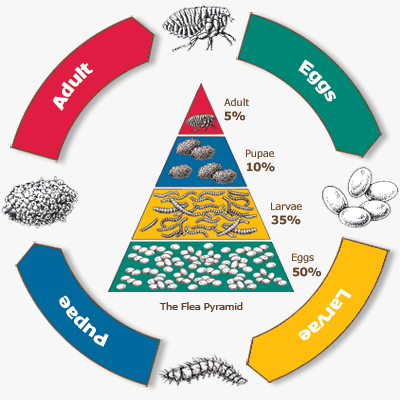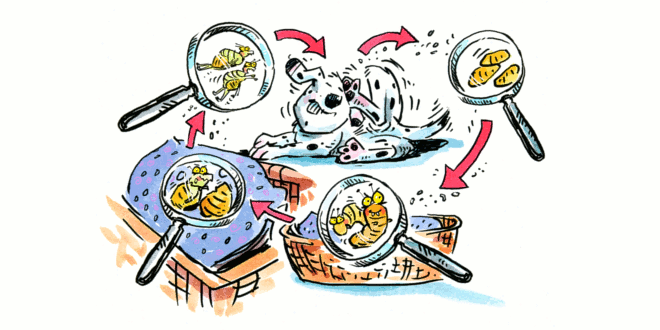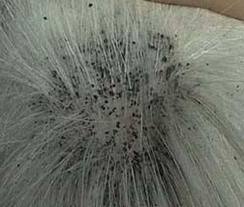Life Cycle:
There are 4 stages of the flea’s life cycle. The life cycle can be any where from 3 weeks to 6 months depending on the external environment.
Picture courtesy of http://fleasinhouse.com/
The life cycle begins after the adult flea has a blood meal from the host, your dog and/or cat. Once the flea has had its first meal then it is capable of reproduction. One adult flea can lay 40 to 50 eggs a day onto the host. Female fleas can lay up to 2,000 eggs in its life time. The adult fleas that you see are only 5% of the actual population. The female lays the eggs which can then fall off into the pet’s immediate environment, bed, blanket, floor, and etc.
Picture courtesy of http://fleasinhouse.com/
The eggs can take 2 days to 2 weeks to hatch. The eggs compose about 50% of the flea population. The primary habitat of the eggs is any where the host inhabits.
The eggs become larvae. Flea larvae feed on any available organic material such as dead insects, feces, and vegetable matter. The larval stage composes approximately 35% of the entire flea population. The larvae are blind and avoid sunlight, keeping to dark places like sand, cracks and crevices, and bedding. They can stay in the larval stage for 1 to 2 weeks, when they develop cocoons and transition into the pupae stage.
The pupae stage is extremely hard to destroy. They can remain in this stage for several months until there is an external stimulus. The external stimulus such as; vibrations, heat, and carbon dioxide indicate that a host is near. Fleas can remain in the larvae or pupae stages even over winter. This is a good reason why your pet should be on a flea preventative year round. Once the pupae change into adults they only have about a week to have their first blood meal. After their first meal they can survive several months between meals.
Diagnosis:
Infestation of fleas can be seen either by the live adult fleas on the animal or by the excrement left by the adult fleas. This excrement is also known as “flea dirt.” A flea comb can be used to comb through the animals hair coat to see flea dirt and/or adult fleas.
Treatment of living area:
If your pets are infested with fleas not only do you need to treat all of your pets, including any out door pets it is also necessary to treat your house as well. JVC has “Knockout” spray for your house. This product is recommended to treat the areas where the pets primarily are including the cracks, crevices, and the floors. You will also want to vaccum the floors. If you have a bag vaccum make sure you throw the bag away outside and if you have a canister make sure you wash it out.
Prevention/Treatment for pets:
- 24 hour protection:
- Capstar will kill all the adult fleas on your pet for 24 hours. This product is good to get the initial adult fleas off.
- Monthly:
- Frontline: Once a month topical protection for your pet.
- Nexgard: Once a month oral flea prevention for your pet
- Bravecto: Oral chew providing 12 weeks of protection.
- Trifexis: This is a combination flea and heartworm once a month prevention for your dog only.
- Revolution: This is a once a month topical flea and heartworm prevention.
Possible health risks caused by fleas:
- Anemia: This is a condition where the body has a decrease in red blood cells. Fleas can consume up to 15 times their weight in blood daily. This can result in significant blood loss in highly infested animals.
- Flea allergy dermititis: This is one of the most common skin conditions seen at a veterinary clinic. It is usually seen with hari loss around tail head and back of rear legs. The pet is very itchy and uncomfortable.
- Tapeworms: (Dipylidium caninum) Your pets can get tapeworms by swallowing infected flea larvae. People can also get tapeworms from animals by the fleas.


